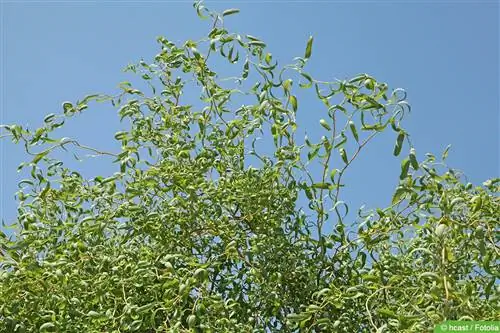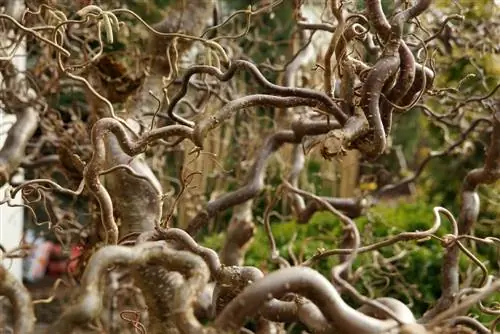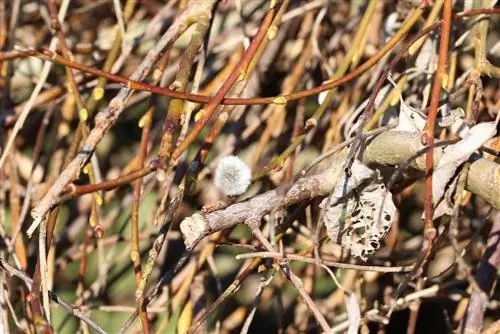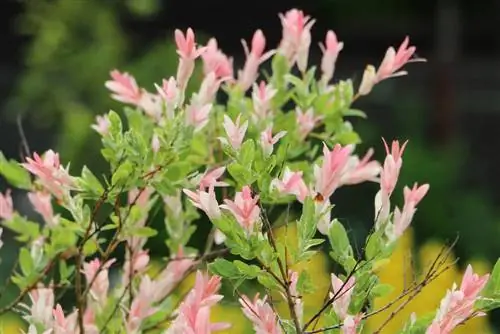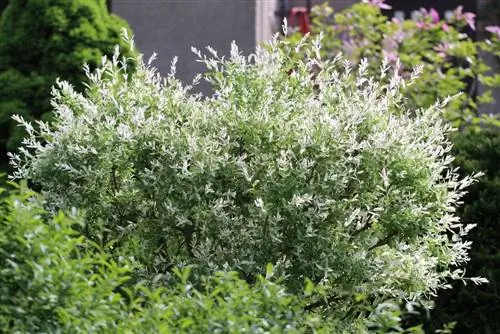- Author admin [email protected].
- Public 2023-12-17 03:39.
- Last modified 2025-01-24 12:45.
The corkscrew willow is undemanding and decorative in the garden or pot. The cultivated form can be recognized by the intertwined branches. With the right care, the willow becomes an ornamental highlight.
Profile
- Plant family: Willow family (Salicaceae)
- Genus: Willows (Salix)
- It is the variety 'Tortuosa' of the Chinese willow (Salix matsudana)
- Origin: Mediterranean region: France, Spain, Italy and Greece
- Growth habit: slim, twisted, decorative
- Growth height: 800 cm to 1,500 cm
- Growth per year: 100 cm
- Flowering time: mid-March to the end of April
- forms inconspicuous, white fruit catkins up to 2.5 cm long
- Leaves: 5 cm to 10 cm, long, twisted, green
Location and soil
Corkscrew willows are undemanding ornamental trees that tolerate a variety of different locations. The most important thing is enough light, because the trees are true sun worshipers. They prefer a warm, full sun spot, but can tolerate light partial shade if there is enough sun throughout the day. Make sure that the tree grows up to one meter per year and should therefore have enough upward space. Due to their strong roots, there should be no building structures, paths, terraces or similar within three to six meters of the pasture. For this reason, corkscrew willow is not suitable for small plots of land. Once you have chosen a location, the soil should be like this:
- no specialization
- must function as a moisture store in summer
- acidic or alkaline soils are tolerated
- sufficiently moist
Note:
Due to the high space requirement, Salix matsudana 'Tortuosa' is ideal as a solitary plant. You can make the ornamental plant an eye-catcher in the garden.
Plants
To successfully plant your corkscrew willow, choose a day between early October and late February. The ground should not be frozen and a day that is not too cold is recommended so that the tree does not freeze.
The following points will help you with planting:
- Dig planting hole
- Planting hole must be twice as big as root ball
- loose up heavy soils with drainage material
- Drainage material: lava grit, gravel
- Incorporate compost into excavated soil
- Drive in the support post
- Insert corkscrew willow
- Do not plant too deep (orientate yourself on the height of the plant in the pot)
- Straighten the tree
- fix to support post
- Fill planting hole with excavated soil
- start well
- water adequately
Repotting
If you have decided to cultivate it in a container, you will have to repot the corkscrew willow at regular intervals. Since the location does not differ from the specimens planted outdoors, the trees grow extremely quickly even in the pot. The roots in particular pose a problem. As soon as they are visible on the surface of the substrate, they are repotted over the summer. The following substrate is suitable for pot cultivation:
- potted plant, garden or compost soil
- humos
- clayey
You also need a container with a volume of at least 80 liters and gravel or lava grit as drainage material. The bucket must have a large drainage hole and be made of clay so that the corkscrew willow does not fall over.

Then proceed as follows:
- Removing corkscrew willow from pot
- use the same or larger pot
- Remove roots from old substrate
- Short the roots thoroughly by several centimeters
- completely remove dried or rotten roots
- Set up a drainage layer at the bottom of the bucket
- Insert plant
- fill and press lightly
- water thoroughly
Pouring
Salix matsudana 'Tortuosa' is only watered in dry times. The soil should be sufficiently moist. Container plants are watered as needed. Check the soil for moisture using a finger test and water accordingly. You don't have to worry about hard water. Corkscrew willow trees can be watered with hard or soft water.
Note:
If you struggle with persistent moisture in the garden, mulch the tree. The mulch layer stores moisture over the hot summer days.
Fertilize
Specimens planted outdoors do not need to be fertilized. In the spring, work a portion of compost and horn shavings into the soil to nourish the pasture over the coming season. Container plants are supplied with liquid green plant fertilizer every two to four weeks from spring to autumn. The fertilizer is administered exclusively via the irrigation water.
Cutting
In order to keep a corkscrew willow as young and he althy as possible, it must be thinned out and cut back annually. Outdoor specimens are cut either in spring or late autumn when there are no longer any leaves on the tree. Depending on their growth, potted plants are thinned out in spring and autumn. In most cases, secateurs are sufficient for cutting. Proceed as follows:
- Disinfect and sharpen tools
- completely remove diseased, dried, weak and dead shoots or branches
- completely remove shoots growing inwards or crossways
- remove the oldest main shoots close to the ground every 2nd season
- cut the remaining branches back to the desired shape and height
- Prune potted plants by a third
Note:
The corkscrew willow tolerates radical pruning without any problems. To do this, shorten the plant by two thirds or plant the tree completely.
Wintering
Overwintering corkscrew willows works without any major problems. Planted trees are absolutely winter hardy and do not require winter protection as long as they are not in the first year after planting. In this case, you should cover the location with brushwood, leaves or straw and pack up the branches. Jute bags or garden fleece are ideal for this. Specimens grown in pots also need winter protection. You don't have to bring the plants indoors, but they still need suitable protection from the cold:
- Cover the substrate with brushwood or leaves
- Pack the pot and plant
- use bubble wrap or garden fleece for this
- Stop fertilizer additions completely
- do not water over winter
Propagate
The propagation of a corkscrew willow is very simple. To do this, cut off slightly longer branches on a frost-free winter day and put them in a container with water. Over the next few weeks, roots will develop, which is a sign for planting outdoors. Propagating cuttings is also easy to implement. The cuttings must be 15 centimeters long and all but five centimeters of foliage must be removed.
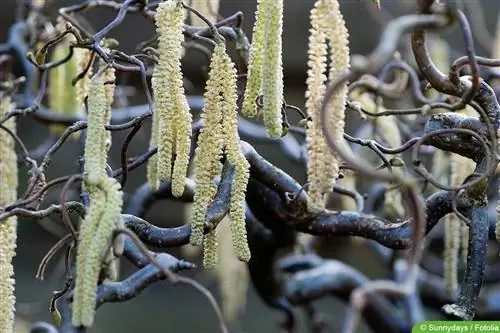
Plant the cuttings in a mixture of quartz sand and potting soil and place the container in a warm but not sunny location. As soon as shoots and foliage form, the plant is either repotted or planted outdoors.
Pests
In order for the corkscrew willow to thrive in the long term, you need to know the possible diseases and pests that can affect the tree. Salix matsudana 'Tortuosa' is quite susceptible to pests and fungal diseases, which makes additional measures necessary. The larvae of the willow borer (Cossus cossus) are particularly dangerous; their infestation can be recognized by the following symptoms:
- Bark smells like vinegar
- Feeding passages visible
- adult specimens recognizable
- Tree weakens until it dies completely
Older trees are better able to withstand willow borer infestation than young trees. Try to contain the infestation by removing infected shoots and branches, as well as the caterpillars. Depending on the severity of the infestation, this is hardly possible anymore, as the larvae are only noticed very late. In this case, you must remove the entire corkscrew willow from the garden and dispose of it properly. An infestation by the spotted willow leaf beetle (Chrysomela vigintipunctata), whose appearance is reminiscent of a light-colored ladybird, is not as serious. An infestation can be recognized by completely bare branches and the animals that spend time on them in midsummer. Older corkscrew willows recover from the beetles on their own. You can help young specimens in the following ways:
- remove infected shoots
- Collect beetles and release them far away
- Use insect repellent in an emergency
Diseases
Diseases also pose a great danger to the corkscrew willow, especially fungal infections. Willow scab (Pollaccia saliciperda) is one of the most common fungal diseases of the corkscrew willow, which manifests itself in the following symptoms:
- Shoots and leaves turn brown
- Shoots and leaves dry up
- individual plant parts turn completely black
- ulcers grow on black spots
The fungus can cause great damage and is difficult to combat, but in most cases adult specimens do not die. You must completely remove the affected parts of the plant (dispose of them exclusively in household waste) and fertilize the plant with a little more potassium and phosphorus in the coming months. The stronger the plant, the lower the chance of another outbreak next year. Since the fungi overwinter in the plant, you can expect an infestation every year. In addition to willow scab, you may also be dealing with Marssonina disease on the corkscrew willow. This is triggered by Marssonina salicicola or Drepanopeziza sphaeroides fungi. An infestation appears as follows:
- Leaves, shoot tips, twigs and flowers wither away
- Up to 3 mm leaf discoloration visible
- affected parts die off completely
To control the fungus next season, you need to collect the autumn leaves, because that's where the fungi overwinter. The more thoroughly you remove the foliage, the lower the chance of reinfection. You can combat an acute infestation as follows:
- remove affected plant parts
- dispose of in household waste
- optionally use fungicides (in case of severe infestation)
Tip:
The he althier your corkscrew willow is, the lower the chance of infection with the fungi. Above all, do not neglect to trim the trees, as branches that are too dense and bare significantly increase the risk of infection.

